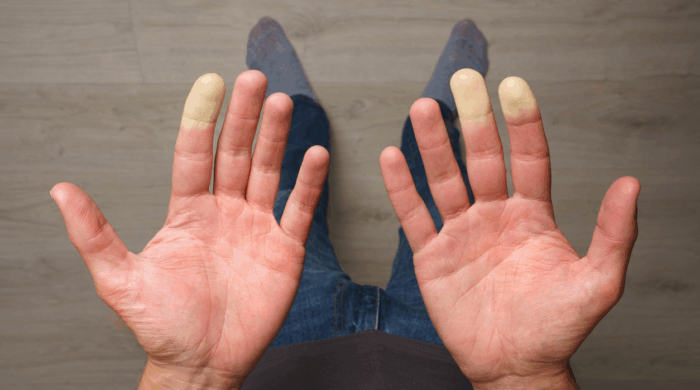It’s a chilly Pacific Northwest winter morning. You’re scraping ice off your car’s windshield. Your fingers start turning pale at the tips. By the time you finish, your fingers are completely white and numb. When you get in the car and warm up, they turn red or purple and tingle uncomfortably as the circulation returns.
If this sounds familiar, you’ve likely experienced an episode of Raynaud’s syndrome, a condition that causes reduced blood flow to the fingers and sometimes the toes, and can be very painful.
For sufferers of Raynaud’s syndrome, episodes can happen intermittently and may last a few minutes or a few hours, with varying degrees of discomfort or pain. Symptoms usually resolve on their own without significant damage to the body. If symptoms are frequent or severe, a healthcare provider can evaluate the patient’s condition and offer medication or other solutions to find relief.
Facts about Raynaud’s
Raynaud’s is commonly referred to as a syndrome, disease, or phenomenon, but for the sake of this article, we will be referring to it simply as Raynaud’s or Raynaud’s syndrome.. According to the National Institutes of Health:
More women than men are affected by Raynaud’s, suggesting that estrogen may play a role.
Individuals with relatives who have Raynaud’s are at higher risk. However, no specific genetic factors have been identified definitively.
Typically, Raynaud’s syndrome is not disabling, but it can negatively affect a person’s quality of life.
What triggers Raynaud’s Syndrome?
- Exposure to cold. Exposure to cold is the most common trigger for Raynaud’s syndrome. For some people, episodes are linked to other triggers.
- Stress. Many factors, including nerve and hormonal signals, control blood flow in skin. Emotional stress, for example, releases signaling molecules that cause blood vessels to narrow.
- Smoking. Cigarette smoking and vaping can also trigger Raynaud’s symptoms.
- Medications. Certain medications used to treat high blood pressure, migraines, or ADHD may cause symptoms similar to those of Raynaud’s, or can worsen existing symptoms.
Controlling Symptoms
Many patients are able to control the symptoms of Raynaud’s with lifestyle modifications. For example, keeping warm can help reduce the frequency and severity of attacks. Ways to end an attack include placing hands or feet in a warm place, such as under warm (not hot) water, under a heating pad, or under the armpits.
When exposed to cold, the body tries to slow the loss of heat and maintain its temperature by redirecting blood flow to the core and away from the extremities (hands and feet). So it’s important to keep the core— chest and abdomen —warm when outdoors in cold weather. We lose a lot of body heat through our head, so hats are also helpful. As are gloves or hand warmers.
Even in warm weather, a sweater or jacket comes in handy for air-conditioned spaces. And no matter the time of year, people with Raynaud’s syndrome should wear gloves when handling cold or frozen items.
Depending on the severity of attacks and symptoms, medications or lifestyle changes guided by a healthcare provider may be needed to manage Raynaud’s syndrome.
Treatment Options
A WWMG primary care provider can make an initial diagnosis of Raynaud’s syndrome based on a review of a patient’s medical history and a physical exam. They can recommend lifestyle changes, or if the patient’s symptoms are persistent or severe, may refer them to a rheumatologist for further evaluation and treatment.
Dr. Andrew Sohn, WWMG Rheumatologist says, “There are several medications that can help” a patient with Raynaud’s. “Many of the medications that increase blood flow to the fingers and toes also lower blood pressure. Depending on their medical history, that may not be advisable for some patients. I work closely each patient to choose the best option for them, and the correct dose so they can find relief.”
Health conditions that co-occur with Raynaud’s
When evaluating a patient for Raynaud’s, a rheumatologist will use a blood test to screen the patient for other health conditions. The most common diseases that can co-occur with Raynaud’s syndrome are scleroderma and lupus. Other conditions may include:
- rheumatoid arthritis
- myositis
- certain thyroid disorders
- some clotting disorders
- carpal tunnel syndrome, or
- Sjögren’s syndrome, an immune system disorder
Finding Support
If you’re suffering from Raynaud’s and would like help, contact us to request an appointment at one of our seven primary care locations. Our providers will assess your condition and recommend individualized treatment, or refer you to a WWMG Rheumatologist for further evaluation if needed.
